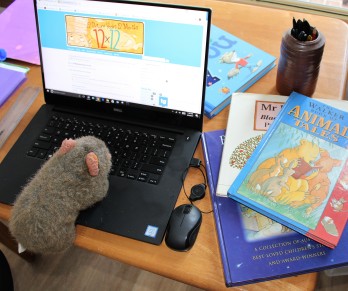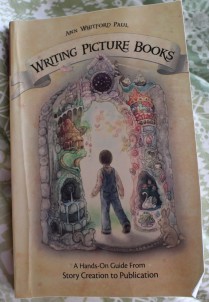 I’m to the halfway point of the annual Picture Book Challenge founded by picture book author, Julie Hedlund. The idea of the 12 X 12 challenge is to write a picture book each month. It’s a challenge I took on in a moment of frustration when I felt like a break from my usual writing genre (middle grade). I love a challenge, or more accurately, I need a kick up the pants in the form of deadlines and cheer-leading. The 12 x 12 challenge is patronised internationally and attracts over 800 participants. The perks of membership and cost are well documented here http://12x12challenge.com/membership/ As I hadn’t done the challenge before I paid for the Shel Silverstein – level membership.
I’m to the halfway point of the annual Picture Book Challenge founded by picture book author, Julie Hedlund. The idea of the 12 X 12 challenge is to write a picture book each month. It’s a challenge I took on in a moment of frustration when I felt like a break from my usual writing genre (middle grade). I love a challenge, or more accurately, I need a kick up the pants in the form of deadlines and cheer-leading. The 12 x 12 challenge is patronised internationally and attracts over 800 participants. The perks of membership and cost are well documented here http://12x12challenge.com/membership/ As I hadn’t done the challenge before I paid for the Shel Silverstein – level membership.
After a quick perusal of the ‘Introduce yourself’ forum on the 12 x 12 member page I deduced that only about 10 % of participants appear to be non-USA citizens.
So what is the Australian experience of 12 x 12 . What are some things to consider?
1. Budget for the exchange rate.
The actual cost of membership was around AUD $200 (USD $147).
The cost of the recommended text, Writing Picture Books by Ann Whitford Paul was AUD $20 and I could only get this through Book Depository.
Last month I also purchased, Picture Book Blueprint, which was a special deal offered by webinar presenter Laura Backes (25% off). This deal wasn’t so special when taking into account the Australian exchange rate. It cost around 200 AUD for lifetime access to the PB blueprint video presentations, downloadable PDF’s and facebook page. This latter purchase was entirely indulgent and it is not a requirement of the challenge. I haven’t used this resource yet but intend to for next month’s effort.
2. The time difference. Live webinars were generally staged at 4 to 6 am Australian time but this is not a huge problem (see below)
3. The picture book market in USA is different.
– Narrative non-fiction particularly picture book biographies seem to be very popular. This isn’t just coming from the webinars and industry experts on the 12 X12 page. For my own interest I asked the members of my critique group (all from USA) what their own children’s favourite picture books were. Many named biographies in their lists.
– More room for niche books – those which address minority groups and issues . The awarded and prolific Australian author Michelle Worthington said at the NSW Writers Festival that her more specialised books such as, Noah chases the Wind, featuring a child with autism, are sold direct to USA publishers.
– There seems to be more leniency with word count. Picture book competitions in Australia and general advice I’ve received from industry insiders advise that texts should not exceed 500 words. In the USA picture books that go up to 900 words seem to be more accepted. I think this is partly due to the popularity of narrative non-fiction.
– Agents seem to be almost mandatory over there whereas most first-time picture book authors here gain publication through direct submission. A consequence of this author- agent relationship, often stated in the 12 X 12 discussions, is that writers should have at least three submission-ready manuscripts before putting one forward to agent. Agents represent authors rather than books and seek clients with depth. In Australia if you have single manuscript that you’ve polished (and polished again) then it is pointless labouring away on another two or three before you submit that first one. Submit, then work on your next book – there is sure to be lots of waiting whether successful or not.
4. Terminology and Australian culture. This is the hardest problem for me to get around when writing for 12 x 12 . It is not just the obvious terminology differences ie thongs vs flip flops, trolleys vs carts, Mum vs mom, but also cultural practices. For instance, the naming of school grades, popular sports and pastimes. I mentioned cricket (the game) in one of my stories, but of course, my US critiquers didn’t get it and many Australian kids can’t relate to baseball (although both my children played the pitching game).
The above three points are not necessarily drawbacks. The following are counterpoints to the above discussions:
1. Cost. The price of this challenge is less that you would pay for one good PB manuscript assessment or one conference registration. The monthly webinars have so far been well-presented and packed with information and relevant examples. Julie Hedlund hosts industry experts which all have something different to offer from polishing/editing, to rhyming and non-fiction and finding ideas that resonate. Julie herself asks the right questions and adds useful anecdotes in an easy-to-listen style. The webinars are worth the price of admission alone but there is also many discussion forums you can join on aspects of picture book writing and a manuscript assessment forum where you can post your picture book texts for comment. I’ve only used the latter feature once for an early draft. I received some good feedback but, to be honest, I’m a little worried about this forum as your text is available to every member of 12 X 12 (800+) so you do this at your own risk. I felt more comfortable when I joined with a small critique group with five members. There are plenty of opportunities to join these smaller critique groups which are advertised in a section called Critique Connect.

This years writing craft book is money well spent. Ann Whitford Paul’s, Writing Picture Books* is packed with ideas on age-appropriateness, structure, voice, character and plot devices. This book was published in 2009 so some of the example texts listed are a bit dated* (although some are ageless) and need to be supplemented with studies of modern texts. This where I’m at a bit of disadvantage as I no longer have young children who bring home books or have the need to buy picture books. However I have gleaned quite a bit from listening to the webinars as they give excellent modern examples. Many picture books readings are available on You-tube although I can’t imagine these videos don’t infringe some sort of copyright laws.
I’ve paid for a year’s subscription to ‘Storybox Library’ which is an Australian site where picture books are read out loud (often by celebrities). This is a lovely site but as a writer there is nothing like having the picture book in your hands to have a close look at the layout, language and page turns. You can source books at libraries but it is easy to get overwhelmed when you go into the children’s section – and there will be some poor quality picture books on the shelves. It is worthwhile doing a little research around the best new picture books including looking at the CBCA Awards for early readers http://cbca.org.au/short-list-2017 for past few years and the koala awards http://www.koalansw.org.au/winners/.
So in short – Yes the price of 12 X 12 is worth it. And I would recommend Ann Whitford Paul’s book* even if you’re not doing the challenge.
2. Time difference. Each webinars is made available as a replay about a week after live event so you can watch at your own leisure – and not necessarily all at once. Of course, with a replay you can’t participate in the live question/answer sessions but I haven’t watched a replay yet where I wished they’d asked this or that question. The replay webinars remain available on login for about a three weeks – so plenty of time to watch. Other forms of communication are not time dependent – the discussion forums are always open and historical discussions kept. I use email for my small critique group and view and occasionally comment on the 12 X 12 facebook page. The two occasions I had a minor queries Kelli Panique (Julie’s administrative assistant) has replied to my emails promptly.
3 & 4 Market. You may want to target the USA market. If this is the case 12 x 12 is a great way to get a feel for what works in the States. It’s good to run your story past US critiquers to test how internationally friendly your characters, setting and language are. Australian author, Mem Fox is hugely popular in the USA – and she even mentioned cricket in Wilfrid Gordon McDonald Partridge. Still, you shouldn’t go into 12 X 12 thinking the US market is easier to crack. 12 X 12 bloggers and social media posts present many, many stories of continual rejections, near misses and years of revising and education. The market may be bigger over there but so are the number of aspiring picture book authors.
***
I am not a model challenger as I have written only three manuscripts so far in the six months but I am quite happy with that given that Julie Hedlund herself says she never actually wins the challenge. And I’m am learning mountains and those mountains are steep. Above all I know now – writing publishable picture books is a lot harder than it looks.
I have taken a departure from my shorts with this post as I had a lot to say. But have a few more shortish posts to go on my other blogs
* Ann Whitford Paul has a new book coming out in 2019, so if you can, wait for this new edition. It will have updated texts and will address, more recent market trends eg self-publishing, shorter text lengths. (heard from a Julie Hedlund/Ann Whitford Paul webinar Jan 2018)

Thanks for this post. It’s great to read about the Australian situation for children’s publishing.
I agree — I think picture books are the hardest form to master (and rhyming ones the hardest of the lot).
If you loved that book by Ann Whitford Paul I would recommend a lesser known book How Picturebooks Work by Maria Nikolajeva and Carole Scott.
LikeLike
Thanks for that recommendation Lynley ! I like that this book seems to have examples of the PB pages within the text. I have gleaned quite a lot about the logistics of Australian picture book publishing because two of the members of my writing group have three books due out in the next 12 months – have followed their journeys. I agree that rhyming books are the hardest to get right but my favourites to read, if done well. I haven’t even attempted as haven’t got a great ear for rhythm and beat. Thanks for stopping by the blog.
LikeLike